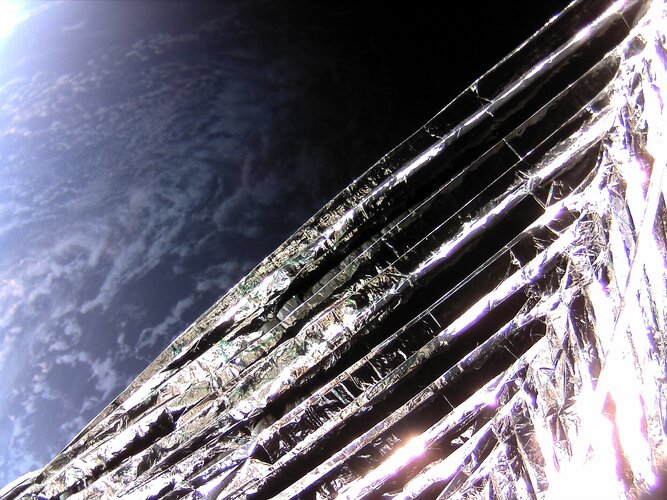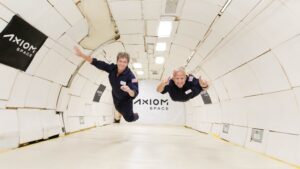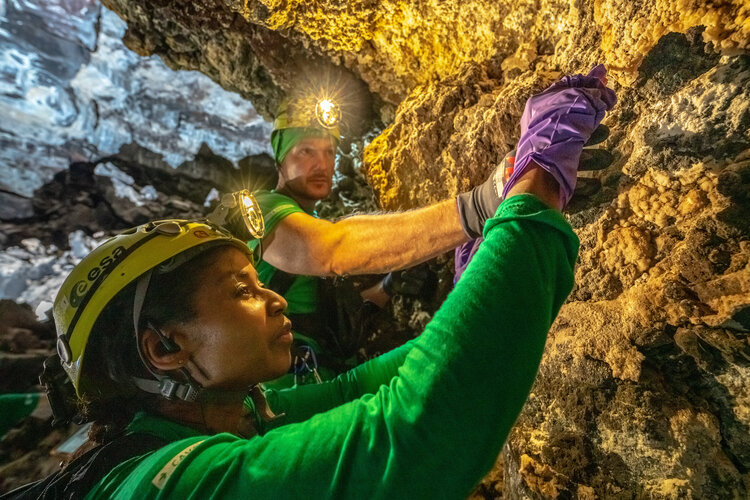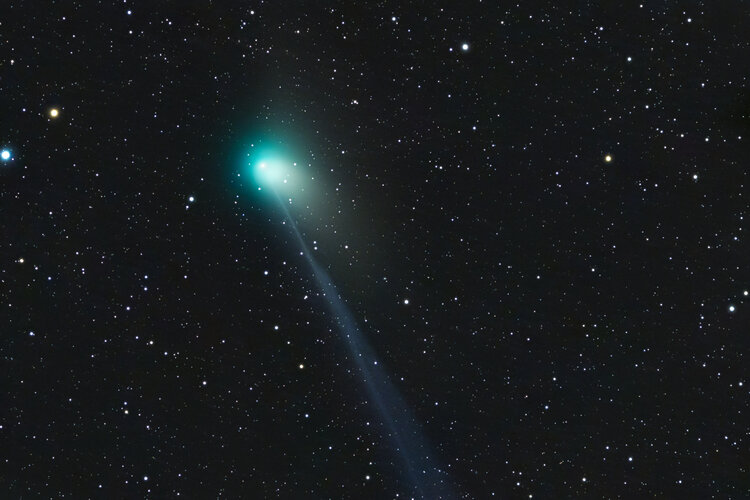Astral alchemy
Wednesday, 01 February 2023 12:10
Osaka, Japan (SPX) Jan 27, 2023
 The Standard Model of particle physics tells us that most particles we observe are made up of combinations of just six types of fundamental entities called quarks. However, there are still many mysteries, one of which is an exotic, but very short-lived, Lambda resonance known as ^(1405).
For a long time, it was thought to be a particular excited state of three quarks-up, down, and strange-
The Standard Model of particle physics tells us that most particles we observe are made up of combinations of just six types of fundamental entities called quarks. However, there are still many mysteries, one of which is an exotic, but very short-lived, Lambda resonance known as ^(1405).
For a long time, it was thought to be a particular excited state of three quarks-up, down, and strange-
 The Standard Model of particle physics tells us that most particles we observe are made up of combinations of just six types of fundamental entities called quarks. However, there are still many mysteries, one of which is an exotic, but very short-lived, Lambda resonance known as ^(1405).
For a long time, it was thought to be a particular excited state of three quarks-up, down, and strange-
The Standard Model of particle physics tells us that most particles we observe are made up of combinations of just six types of fundamental entities called quarks. However, there are still many mysteries, one of which is an exotic, but very short-lived, Lambda resonance known as ^(1405).
For a long time, it was thought to be a particular excited state of three quarks-up, down, and strange- Turning astronauts into Moon explorers
Wednesday, 01 February 2023 10:37ESA YGT applications now open!
Wednesday, 01 February 2023 09:27
The 2023 Young Graduate Trainee positions are now open for applications! Opportunities are available in engineering, science, IT and business services. Find out more and apply now.
Setting sail for safer space
Wednesday, 01 February 2023 07:17 Image:
Setting sail for safer space
Image:
Setting sail for safer space Governments to be major customers of future Axiom Space private astronaut missions
Wednesday, 01 February 2023 06:05
Axiom Space says the customers for its upcoming private astronaut missions to the International Space Station are dominated by governments rather than individuals.
The post Governments to be major customers of future Axiom Space private astronaut missions appeared first on SpaceNews.
Two nearby exoplanets might be habitable
Wednesday, 01 February 2023 03:47
Pasadena CA (JPL) Feb 01, 2023
 The discovery: Two planets about as massive as Earth orbit a red-dwarf star only 16 light-years away - nearby in astronomical terms. The planets, GJ 1002 b and c, lie within the star's habitable zone, the orbital distance that could allow liquid water to form on a planet's surface if it has the right kind of atmosphere.
Key facts: Whether red-dwarf stars are likely to host habitable worlds
The discovery: Two planets about as massive as Earth orbit a red-dwarf star only 16 light-years away - nearby in astronomical terms. The planets, GJ 1002 b and c, lie within the star's habitable zone, the orbital distance that could allow liquid water to form on a planet's surface if it has the right kind of atmosphere.
Key facts: Whether red-dwarf stars are likely to host habitable worlds
 The discovery: Two planets about as massive as Earth orbit a red-dwarf star only 16 light-years away - nearby in astronomical terms. The planets, GJ 1002 b and c, lie within the star's habitable zone, the orbital distance that could allow liquid water to form on a planet's surface if it has the right kind of atmosphere.
Key facts: Whether red-dwarf stars are likely to host habitable worlds
The discovery: Two planets about as massive as Earth orbit a red-dwarf star only 16 light-years away - nearby in astronomical terms. The planets, GJ 1002 b and c, lie within the star's habitable zone, the orbital distance that could allow liquid water to form on a planet's surface if it has the right kind of atmosphere.
Key facts: Whether red-dwarf stars are likely to host habitable worlds Scientists release newly accurate map of all the matter in the universe
Wednesday, 01 February 2023 03:47
Chicago IL (SPX) Feb 01, 2023
 Sometimes to know what the matter is, you have to find it first. When the universe began, matter was flung outward and gradually formed the planets, stars and galaxies that we know and love today. By carefully assembling a map of that matter today, scientists can try to understand the forces that shaped the evolution of the universe.
A group of scientists, including several with the Univer
Sometimes to know what the matter is, you have to find it first. When the universe began, matter was flung outward and gradually formed the planets, stars and galaxies that we know and love today. By carefully assembling a map of that matter today, scientists can try to understand the forces that shaped the evolution of the universe.
A group of scientists, including several with the Univer
 Sometimes to know what the matter is, you have to find it first. When the universe began, matter was flung outward and gradually formed the planets, stars and galaxies that we know and love today. By carefully assembling a map of that matter today, scientists can try to understand the forces that shaped the evolution of the universe.
A group of scientists, including several with the Univer
Sometimes to know what the matter is, you have to find it first. When the universe began, matter was flung outward and gradually formed the planets, stars and galaxies that we know and love today. By carefully assembling a map of that matter today, scientists can try to understand the forces that shaped the evolution of the universe.
A group of scientists, including several with the Univer NASA Spinoffs bolster climate resilience, improve medical care, more
Wednesday, 01 February 2023 03:47
Greenbelt MD (SPX) Feb 01, 2023
 When it comes to NASA, most people look to the skies as rockets, rovers, and astronauts push the boundaries of space exploration. But the benefits of going above and beyond can be found here on Earth through products and services born from NASA innovation.
The latest edition of NASA's Spinoff publication features dozens of new commercialized technologies that use the agency's technology, r
When it comes to NASA, most people look to the skies as rockets, rovers, and astronauts push the boundaries of space exploration. But the benefits of going above and beyond can be found here on Earth through products and services born from NASA innovation.
The latest edition of NASA's Spinoff publication features dozens of new commercialized technologies that use the agency's technology, r
 When it comes to NASA, most people look to the skies as rockets, rovers, and astronauts push the boundaries of space exploration. But the benefits of going above and beyond can be found here on Earth through products and services born from NASA innovation.
The latest edition of NASA's Spinoff publication features dozens of new commercialized technologies that use the agency's technology, r
When it comes to NASA, most people look to the skies as rockets, rovers, and astronauts push the boundaries of space exploration. But the benefits of going above and beyond can be found here on Earth through products and services born from NASA innovation.
The latest edition of NASA's Spinoff publication features dozens of new commercialized technologies that use the agency's technology, r NASA announces finalists in challenge to design future astronaut food
Wednesday, 01 February 2023 03:47
Molly Porter fort MSFC
 Huntsville AL (SPX) Feb 01, 2023
NASA has selected 11 finalists in Phase 2 of the Deep Space Food Challenge, a public competition to extend the limits of humans in space - through food.
A first-of-its-kind coordinated effort between NASA and the Canadian Space Agency (CSA), the Deep Space Food Challenge aims to kickstart future food systems for pioneering missions to the Moon, Mars, and b
Huntsville AL (SPX) Feb 01, 2023
NASA has selected 11 finalists in Phase 2 of the Deep Space Food Challenge, a public competition to extend the limits of humans in space - through food.
A first-of-its-kind coordinated effort between NASA and the Canadian Space Agency (CSA), the Deep Space Food Challenge aims to kickstart future food systems for pioneering missions to the Moon, Mars, and b
 Huntsville AL (SPX) Feb 01, 2023
NASA has selected 11 finalists in Phase 2 of the Deep Space Food Challenge, a public competition to extend the limits of humans in space - through food.
A first-of-its-kind coordinated effort between NASA and the Canadian Space Agency (CSA), the Deep Space Food Challenge aims to kickstart future food systems for pioneering missions to the Moon, Mars, and b
Huntsville AL (SPX) Feb 01, 2023
NASA has selected 11 finalists in Phase 2 of the Deep Space Food Challenge, a public competition to extend the limits of humans in space - through food.
A first-of-its-kind coordinated effort between NASA and the Canadian Space Agency (CSA), the Deep Space Food Challenge aims to kickstart future food systems for pioneering missions to the Moon, Mars, and b Is there life on Mars? Maybe, and it could have dropped its teddy
Wednesday, 01 February 2023 03:47
Los Angeles (AFP) Jan 31, 2023
 Yogi, Paddington and Winnie the Pooh, move over. There's a new bear in town. Or on Mars, anyway.
The beaming face of a cute-looking teddy bear appears to have been carved into the surface of our nearest planetary neighbor, waiting for a passing satellite to discover it.
And when the Mars Reconnaissance Orbiter passed over last month, carrying aboard the most powerful camera ever to ventu
Yogi, Paddington and Winnie the Pooh, move over. There's a new bear in town. Or on Mars, anyway.
The beaming face of a cute-looking teddy bear appears to have been carved into the surface of our nearest planetary neighbor, waiting for a passing satellite to discover it.
And when the Mars Reconnaissance Orbiter passed over last month, carrying aboard the most powerful camera ever to ventu
 Yogi, Paddington and Winnie the Pooh, move over. There's a new bear in town. Or on Mars, anyway.
The beaming face of a cute-looking teddy bear appears to have been carved into the surface of our nearest planetary neighbor, waiting for a passing satellite to discover it.
And when the Mars Reconnaissance Orbiter passed over last month, carrying aboard the most powerful camera ever to ventu
Yogi, Paddington and Winnie the Pooh, move over. There's a new bear in town. Or on Mars, anyway.
The beaming face of a cute-looking teddy bear appears to have been carved into the surface of our nearest planetary neighbor, waiting for a passing satellite to discover it.
And when the Mars Reconnaissance Orbiter passed over last month, carrying aboard the most powerful camera ever to ventu The faults and valleys of a Martian volcanic highland plateau
Wednesday, 01 February 2023 03:47
Berlin, Germany (DLR) Feb 01, 2023
 January's 'Mars Image of the Month' reveals a geologically complex region on the flanks of Thaumasia Planum, an extensive volcanic plateau in the highlands southeast of the Valles Marineris valley system. The image data was acquired using the High Resolution Stereo Camera (HRSC) on board ESA's Mars Express mission. HRSC is a camera experiment developed and operated by the German Aerospace Center
January's 'Mars Image of the Month' reveals a geologically complex region on the flanks of Thaumasia Planum, an extensive volcanic plateau in the highlands southeast of the Valles Marineris valley system. The image data was acquired using the High Resolution Stereo Camera (HRSC) on board ESA's Mars Express mission. HRSC is a camera experiment developed and operated by the German Aerospace Center
 January's 'Mars Image of the Month' reveals a geologically complex region on the flanks of Thaumasia Planum, an extensive volcanic plateau in the highlands southeast of the Valles Marineris valley system. The image data was acquired using the High Resolution Stereo Camera (HRSC) on board ESA's Mars Express mission. HRSC is a camera experiment developed and operated by the German Aerospace Center
January's 'Mars Image of the Month' reveals a geologically complex region on the flanks of Thaumasia Planum, an extensive volcanic plateau in the highlands southeast of the Valles Marineris valley system. The image data was acquired using the High Resolution Stereo Camera (HRSC) on board ESA's Mars Express mission. HRSC is a camera experiment developed and operated by the German Aerospace Center Making the Most of Limited Data: Sols 3278-3279
Wednesday, 01 February 2023 03:47
Pasadena CA (JPL) Feb 01, 2023
 The Sol 3727 drive went well, positioning the rover at the transition in the Marker Band that was the goal of the drive. As expected, we did not receive enough image data to allow DRT brushing to be planned, but we were able to plan APXS and MAHLI observations of a rough bedrock target named "Primavera."
The lack of complete, full-resolution Navcam coverage made it more challenging than us
The Sol 3727 drive went well, positioning the rover at the transition in the Marker Band that was the goal of the drive. As expected, we did not receive enough image data to allow DRT brushing to be planned, but we were able to plan APXS and MAHLI observations of a rough bedrock target named "Primavera."
The lack of complete, full-resolution Navcam coverage made it more challenging than us
 The Sol 3727 drive went well, positioning the rover at the transition in the Marker Band that was the goal of the drive. As expected, we did not receive enough image data to allow DRT brushing to be planned, but we were able to plan APXS and MAHLI observations of a rough bedrock target named "Primavera."
The lack of complete, full-resolution Navcam coverage made it more challenging than us
The Sol 3727 drive went well, positioning the rover at the transition in the Marker Band that was the goal of the drive. As expected, we did not receive enough image data to allow DRT brushing to be planned, but we were able to plan APXS and MAHLI observations of a rough bedrock target named "Primavera."
The lack of complete, full-resolution Navcam coverage made it more challenging than us Lockheed Martin's first LM 400 Multi-Mission Spacecraft completed
Wednesday, 01 February 2023 03:47
Denver CO (SPX) Feb 01, 2023
 The first Lockheed Martin (NYSE: LMT) LM 400, a flexible, mid-sized satellite customizable for military, civil or commercial users, rolled off the company's digital factory production line and is advancing toward its planned 2023 launch.
The agile LM 400 spacecraft bus design enables one platform to support multiple missions, including remote sensing, communications, imaging, radar and per
The first Lockheed Martin (NYSE: LMT) LM 400, a flexible, mid-sized satellite customizable for military, civil or commercial users, rolled off the company's digital factory production line and is advancing toward its planned 2023 launch.
The agile LM 400 spacecraft bus design enables one platform to support multiple missions, including remote sensing, communications, imaging, radar and per
 The first Lockheed Martin (NYSE: LMT) LM 400, a flexible, mid-sized satellite customizable for military, civil or commercial users, rolled off the company's digital factory production line and is advancing toward its planned 2023 launch.
The agile LM 400 spacecraft bus design enables one platform to support multiple missions, including remote sensing, communications, imaging, radar and per
The first Lockheed Martin (NYSE: LMT) LM 400, a flexible, mid-sized satellite customizable for military, civil or commercial users, rolled off the company's digital factory production line and is advancing toward its planned 2023 launch.
The agile LM 400 spacecraft bus design enables one platform to support multiple missions, including remote sensing, communications, imaging, radar and per ATLAS works with AWS to advance federated network and expand ground station coverage
Wednesday, 01 February 2023 03:47
Traverse City MI (SPX) Feb 01, 2023
 ATLAS Space Operations, a leading Ground Software as a Service (GSaaS) provider, has announced that it is the first provider to join the Amazon Web Services (AWS) Solution Provider Program (SPP) to resell AWS Ground Station, a fully managed ground station infrastructure which lets customers control satellite communications, process data, and scale their operations.
The SPP is an official A
ATLAS Space Operations, a leading Ground Software as a Service (GSaaS) provider, has announced that it is the first provider to join the Amazon Web Services (AWS) Solution Provider Program (SPP) to resell AWS Ground Station, a fully managed ground station infrastructure which lets customers control satellite communications, process data, and scale their operations.
The SPP is an official A
 ATLAS Space Operations, a leading Ground Software as a Service (GSaaS) provider, has announced that it is the first provider to join the Amazon Web Services (AWS) Solution Provider Program (SPP) to resell AWS Ground Station, a fully managed ground station infrastructure which lets customers control satellite communications, process data, and scale their operations.
The SPP is an official A
ATLAS Space Operations, a leading Ground Software as a Service (GSaaS) provider, has announced that it is the first provider to join the Amazon Web Services (AWS) Solution Provider Program (SPP) to resell AWS Ground Station, a fully managed ground station infrastructure which lets customers control satellite communications, process data, and scale their operations.
The SPP is an official A 


